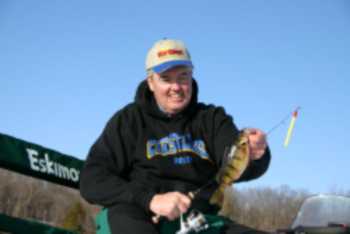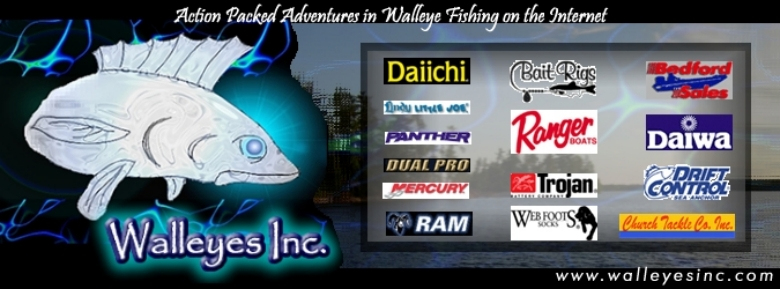Late winter is the perfect time for chasing
jumbo perch. By then the walleye fishing can slow down, (maybe
way down) so why not keep a good thing going and make a switch
to a fish that keeps on biting, and biting. It’s not
that big eye poppin’ perch suddenly turn on and go on
a mad rampage as there are some good catches made all season
long. It’s just that by late ice they’re more
likely to be bunched up and the odds of finding at least a
few that are in the right mood greatly increases. During the
hard water period there are seasonal movements that can lead
perch from shallow water to deep, and back again. The thing
is; after the earliest part of the season most of the action
is hit and miss. The mega schools you can run into at first
ice seem to bust up and you’re more likely to find little
wolf packs of perch here and there, and the action becomes
a lot more sporadic. However, by late ice those little packs
come together and start to show up in masse and can be found
holding along shoreline related structure like hard bottom
breaks and drop offs. Other key areas are main lake basins
and soft bottom flats out in the middle of nowhere. If the
truth be known structure fish are a lot easier to find than
those running the flats. On the other hand; flat fish tend
to run much bigger on average, and may be your best bet for
icing numbers of true jumbos. Structure gives you a starting
point and is something to key on when you start looking from
scratch.
|

Ron Anlauf used a red hot technique to nail this late
winter jumbo
|
By starting close you may save yourself some time, especially
if the little buggers have already started making their
move back in. A good plan of action would start with a
shoreline break and head deeper and deeper until you may
eventually end up a mile or more off shore, out in the
middle of nowhere. When you start looking don’t
be afraid to get into shallow water before heading out
into the deep. If you start too deep you could miss the
whole thing and waste valuable fishing time |
A good example of that occurred a some years back when I
got wind of a hot bite on the west side of Mille Lacs Lake
off of a shoreline break very late in the season. My son and
I were going to cash in on the fun and arrived with high hopes
(we always do), and started with the break where it dropped
from fourteen feet of water into about twenty. The fish just
weren’t there so we kept heading deeper and deeper and
drilling hole after hole with little to show for our efforts.
We’d punch a hole and give it about fifteen or twenty
minutes for any sign of life to show up before moving on to
the next. After about four or five hours of rather fruitless
angling we decided to head back. On the way in we thought
we’d give it one last try and picked it up where we
had started and headed shallow instead. After a few holes
and a couple of moves we found them big time, in about ten
feet of water. We quickly put together a decent catch but
it could have been a whole lot better if we had just started
where we finished. Great perch baits include jigging spoons
like the 1/16oz Northland Buck-Shot Rattle Spoon tipped with
half of a fathead minnow. The Buck-Shot can draw them in from
a long way off and you may want to give it some extra time
before you give up on a spot. Another advantage to the spoon
is the fact that it gets down the hole fast and fast is exactly
what you need when you're over a hot bunch of jumbos. They
can turn on and off at the drop of a hat so you better make
the best of it while you can. A set line with a jig tipped
with a spike or waxie is another good option and can be used
in conjunction with the spoon. Jigs like Northland Tackle’s
new Mud Bug will often trigger fish that have come in for
a look at the spoon but aren't charged up enough to take it.
A Mud Bug combined with a light action rod sitting perfectly
still in a holder is the best setup for the technique and
about all the action you'll need to get the right response.
Another hot new bait that jumbo perch are going to have a
hard time resisting is the Northland Bloodworm, which mimics
the size and shape of a type of insect larvae and is a natural
forage. Perch can often be found jammed full of the stuff
and should be perfect for working tight to the bottom. Another
consideration when you’re on the hunt is the fact that
late ice perch location can vary from year to year and you
never really know for sure where the good action is going
to be. Just because a spot was hot last year doesn’t
mean it will be the same this season. The thing is; to be
consistent you better be ready to make some moves and drill
a few holes (maybe a ton) to get the job done. See you on
the late ice.
Ron Anlauf
|

